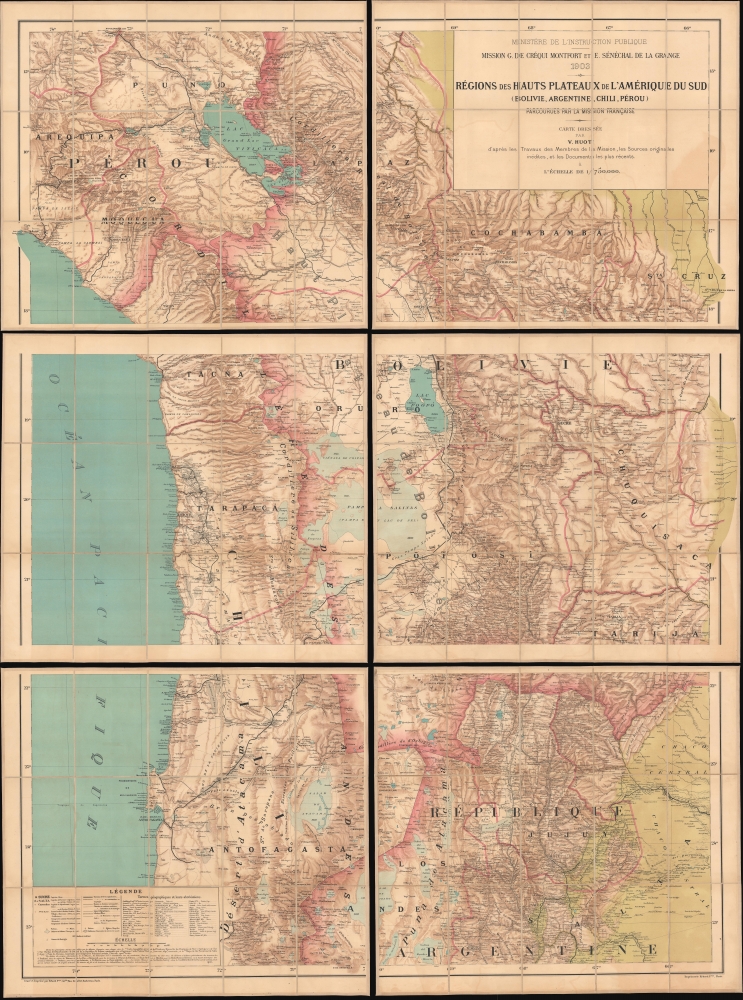1905 Victor Huot Map of the Andes Mountain Region of South America
HautsPlateaux-huot-1905
Title
1905 (dated) 73.25 x 54.5 in (186.055 x 138.43 cm) 1 : 750000
Description
A Closer Look
This tremendous map, presented on six separate sheets dissected for folding, covers the high plateau of South America from 15° to 26° south latitude. It thus encompasses northern Chile, Argentina, and the southern parts of Peru and Bolivia. Lakes Titicaca and Poopó are shown. The map is abundantly detailed. Relief is pictorial, but important mountain peaks are marked and named, with their altitudes given in meters. Salt pans, in particular, are shown in profusion, as well as deposits of saltpeter. Rivers are noted. Keyed to an extensive legend, the map notes settlements ranging from cities to small villages and individual churches. Forts, mines, missions, and archaeological ruins are marked. Battle sites are also identified. Railroads are distinguished between those in use, projected, and under construction. Roads passable by automobile are mapped, as well as mule paths.Contested Borders
Chile is mapped from Antofagasta province in the south to Tacna in the north, with the Peruvian border at Rio Sama, as it was before the 1929 Treaty of Lima. In Tacna province, Alto de la Alianza marks the site of the Battle of Tacna, where combined Bolivian and Peruvian forces were made to retreat by the Chilean Army on May 26, 1880, during the War of the Pacific, also known as the Nitrate War. (The map marks abundant sites for the mining of sodium nitrate, a vital ingredient for both fertilizer and gunpowder.)Pre-Incan RuinsIn Argentina's Salta and Jujuy provinces, the sites of several pre-Incan sites are marked. These attracted the interest of Créqui-Montfort and archaeologist Eric Boman and include the ruins of Morohuasi in Ojo de Agua (Salta, Argentina) and the Tinti ruins in the Lerma valley (also in the Salta province).Publication History and Census
This map was executed by Victor Huot and published in Paris by Erhard Brothers in 1905. We see six examples in institutional collections.
Publication History and Census
This map was executed by Victor Huot and published in Paris by Erhard Brothers in 1905. We see six examples in institutional collections.CartographerS
Victor Huot (August 26, 1867 - April 28, 1915) was a French cartographer. Little is known of his youth. He was employed by the publisher Hachette et Cie., contributing to its map publications such as the Atlas Universel de Geographie by Vivien Martin and Schrader. He produced maps for La Geographie, published by the Paris Geographical Society, of which he was a member. He produced a set of maps of the river basins of the French Alps for the Service des Grandes Forces Hydrauliques, and wrote the South America section for Onesime Reclus' Grande géographie Bong. He produced the monumental map of the Andes, surveyed by the 1903 French Scientific Mission. He developed an international reputation, becoming a member of the American Geographical Society. In 1915, Huot was a member of the French Army, likely the territorial reserves, which were fighting on the Western Front. At the time, Huot was above the age of service. (Even the oldest French conscripts, the territorials, were drawn from men below 45 years of age.) Huot was killed in battle on April 27 or 28, 1915, at the age of 48. This was probably in the Second Battle of Ypres. Although territorials were not intended for front line deployment, losses in the beginning of the war were so sharp that at Ypres these old reserves were in the front line when Germany made their first gas attacks, beginning on April 22. More by this mapmaker...
Henri Georges de Créqui-Montfort (September 27, 1877 – April 4, 1966) was a French explorer, anthropologist, diplomat, businessman, and sport shooter. He was born in Normandy to ballerina Eugénie Fiocre and the landowner and aristocrat Stanislas Le Compasseur de Créqui-Montfort Marquis de Courtivron. Little is known of his upbringing, although he had a full education and took degrees in literature and law. In 1896, he would be among those awarded the Drummond Castle medal, presented by the British Embassy on behalf of Queen Victoria for assisting in the rescue of the SS Drummond Castle on June 16, 1896 (mainly the rescue of bodies, since there were only three survivors of the sinking).
His contribution to the cartographic world appears to have been his role as Chef de la mission scientifique Française en Amérique du Sud between 1903-1904, to which he was assigned by the Ministry of Public Education. He surveyed and explored the Andean highlands with Eugène Sénéchal. With Argentine archaeologist Eric Boman, he discovered the pre-Inca site of Tastil. As part of the mission, he was ultimately responsible for the mission's archaeological excavations on a Tiahuanaco site. As part of his ethnographic and archaeological work, he brought numerous objects back to Paris with the aim of forming a future museum of Amerindian archeology in Paris. He would be awarded a gold medal by The Geographical Society in 1910.
During World War I, he served as infantry captain. In 1917, he was assigned to the High Commission of the French Republic in the United States, serving in Washington as aide-de-camp to General Henri Claudon, head of the French military mission responsible for training American troops. In 1919 he was awarded the Croix de guerre avec palmes. After the war, he served in various diplomatic roles in Canada and the United States. In 1953 he would be made Commandeur de la Légion d'Honneur.
Much of his history is obscured by his achievements as an Olympic sport shooter. He competed in the 1912 and 1924 Summer Olympics, both in clay pigeon shooting and the team 30-meter dueling pistol and the 25-meter rapid-fire pistol events. Learn More...






